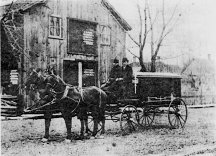 Illiopolis
Business Association
Illiopolis
Business Association 
Return to Centennial History Index
 Illiopolis
Business Association
Illiopolis
Business Association 
Local History
(Taken from the Centennial History of Illiopolis 1956)
 Mr.
E. M. Wurl's Hearse
Mr.
E. M. Wurl's Hearse
In
March of 1869, the year the village adopted the name, Illiopolis, government
under a Town Council was organized with the following charter members: David
Binkley, John S. Hampton, John Blain, Miles H. Wilmot, and Peter Rasor.
Because
of the flatness of the town drainage has always been a problem and there were
many sections of swampy land which were good skating ponds in winter but were
unfit for dwelling houses until drained. On
some streets ditches carried off the water.
The first homes were built on the higher lands.
The
town grew rapidly at first and stores, mostly frame buildings, were of a variety
to supply the basic needs of the community.
Newspaper advertisements represent W. A. Matthews and Bradley and Peden
as leading firms. Mr. Matthews,
who came with his brother, in-law at about the age of nineteen, was a dry goods
merchant. Bradley and Peden were
grocers.
Of
the early business houses, that established by W. H. Fait continued to be
carried on by the same family over the longest period of time.
Mr. Fait, a native of Albany, New York, came to the prairies alone at the
age of fifteen soon after the beginning of the Civil War. Having earned an education he taught school several years,
engaged in farming for a time, then opened a grocery store.
This business was expanded to include dry goods and clothing and occupied
three storerooms south of the Masonic Opera House.
His son, Charles E. Fait, continued the business after his father's
retirement.
A
favorite place for women of the community to combine shopping with visiting, was
Miss Kate Ream's millinery store. Hats
then were not bought ready-to-wear. First,
a becoming frame was chosen, then the trimming of flowers, ribbons, or plumes
selected, according to the season. The
following year, the hat or bonnet was returned to be remodeled and worn again.
On
December 24, 1890, the Farmers' State Bank opened for business in their new
brick building on the lot, which had been purchased from George Smith next to A.
D. Gilbert's store. The
stockholders had elected the following directors: George Smith, W. F. Correll,
George E. Ford, A. H. Loose, I. C. Loose, John Leonard, Sr., M. E. Baker, John
Augur, and David Millikin. George
Smith was chosen president, W. Ft Correll, vice president, and G. E. Ford,
cashier. When the State Bank, which had been organized by F.W. Tracy,
G. W. Constant, and W. W. Tracy, sold their institution to the
Farmers' State Bank, Mr. John Sheller was elected assistant cashier and
two years later was cashier.
In
1896 the frame stores on the east side of Fifth Street and on around the corner
were destroyed by fire. These were
replaced by brick buildings. One
bears the name of D. W. Peden who erected both business houses and residences.
Others of the older buildings have been remodeled or razed and new ones
built on their locations.
There are now only three of the original buildings left.
Of these, the American Legion Building is the oldest.
The two others are the corner store until recently owned by Mr. A. P.
Bichenbach, who purchased the drug business of W. G. McNeir in 1901, and the
former Farmers' State Bank building east of this.
Today
the citizens of Illiopolis may justly take pride in their neat and modern
business district whose appearance gives no indication that the village is now a
century old.